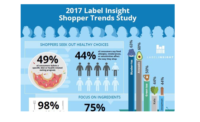As you dig into labeling options for your product container, you’ll see one term pop up again and again: BOPP. It stands for biaxially oriented polypropylene, and it’s an incredibly popular label material.
There are countless benefits to choosing BOPP for your product label — printability, durability and customizability, just to name a few. Like anything, BOPP has its limitations, but across container types, product categories and label designs, you’ll find BOPP specified as the facestock more times than not.
BOPP is polypropylene film which is stretched in both machine and cross directions during production. And a lot of the differences between BOPP and other films can be traced back to this manufacturing method.
BOPP Vs. Alternative Films
The biaxial orientation of BOPP material aligns the polymer chains, increasing the film’s modulus and tensile strength. Machine-direction oriented (MDO) films, which are stretched in only one direction, are less rigid and more conformable than BOPP. Unoriented films offer great conformability for squeezable containers but are less easily printed and dispensed.
The manufacturing method of the film, and the inherent properties of polypropylene films, lend BOPP labels a range of properties like:
- Clarity, allowing brands to achieve the “no-label” look.
- Water, UV and chemical resistance, making BOPP suitable for even the most acidic products and moist environments.
- Excellent printability, especially as BOPP is often equipped with a topcoat which anchors the ink to the surface of the film.
- Rigidity, making BOPP labels easy to die-cut, dispense and apply the label to your container.
Is BOPP Right For Your Label?
Label material selection is about finding a construction that works with your container shape, meets your aesthetic preferences, will perform in your product’s environment (e.g., shower, outdoors, kitchen cupboard, etc.) and fits within your packaging budget.
You’ll start with your label vision — how you want your label to look — and then find those materials that will bring it to life without wrinkling, degrading or popping off your container throughout the entire product lifecycle:, which includes manufacturing, storage, shipping, retail display and customer use.
Material selection conversations never start with, “Do I use BOPP or another material?” BOPP is chosen so often simply because it checks all of the boxes in many situations, is widely available and competitively priced.
Film labels (including BOPP, PE, PO and vinyl) tend to be more expensive than paper labels. And within BOPP materials, costs will vary slightly depending on color (metallized, clear or white) and gauge (thickness). Ultimately, though, the most important factor affecting label costs is order size. The larger the order, the smaller the per-label cost difference between label materials will be.
When You Shouldn’t Use BOPP
During the selection process your label converter will typically ask questions like:
- Do you have a non-standard container (e.g., tubes and highly contoured containers)?
- Is your container squeezable?
- In what environment will your product be used?
- Can you describe your vision for the look of your label?
If you answered “yes” to the first two questions, you shouldn’t choose BOPP. For highly contoured or squeezable containers, non-rigid, conformable films like PE and polyolefin (PO) are your best bet.
In regard to environment, BOPP will degrade in the extreme conditions. If your product will be used or stored outdoors, you’d do well by choosing a vinyl or polyester label film instead. But in practically every other situation, BOPP will work just fine — and the decision about whether or not to use it boils down to budget and aesthetic preferences.
Want a rich, textured feel? Then estate paper is a good choice. Need a bar code label? A cheaper paper label will probably suffice. Want your consumers to see directly into the container? Then clear BOPP is perfect.
Nearly any label vision can be brought to life with BOPP. About the only thing you can’t do is emboss them. They’re easily die-cut, meaning you can get BOPP labels in any custom shape. You can choose between removable or permanent adhesives, depending on what your application requires. And you can choose between three colors: Clear BOPP to achieve the “no-label” look, silver BOPP for a premium, metallic sheen or white BOPP to make your label graphics pop on the shelf.
Achieving “No-Label” Look
Clear BOPP labels can be designed, printed and applied to give the illusion that the graphics are directly printed on the product container. To achieve this look, you’ll need to carefully consider your graphics, container and the color of your product.
Your label design should have thick lines, larger text and high-contrast colors outlining any art (e.g., a dark green leaf outlined with a lighter green color). All art should be in contrast to the color of the container or the product, if visible. And this look is best achieved on smooth, shiny surfaces like glass, rigid plastic and coated paperboard.
Starting with silver BOPP, you can achieve a wide range of packaging looks. You’ll block out the silver using opaque white ink under where you’ll print your artwork, so it pops. Then you can either leave the unprinted areas silver, or you can print over them with translucent CMYK inks to achieve any gold or copper tone, or to add a metallic sheen to any other color.
Make Your Labels Pop
Varnishes and protective laminate layers are essential on BOPP labels to prevent ink from scratching and running. But it doesn’t have to be a purely functional feature. You can use contrasting spot and gloss varnishes, and combinations of both to highlight features in your artwork.
Gloss finishes create reflective, eye-catching labels. Matte finishes over metallic BOPP diffuse the light and give the labels a soft glow. On clear BOPP labels, you can use a slightly textured, matte varnish over your label for a tactile papery feel.
So why is BOPP the go-to material for film labels? Well, to put it simply, it’s easily customized, it looks good on the shelf and it performs in almost every product use environment.
|
Sustainability Drive Is Good News for BOPP Film The global Biaxially Oriented Polypropylene (BOPP) film market has seen demand grow by just under 5 percent per annum over the last five years. The main driver of growth has been the demand for flexible packaging, particularly in China and South East Asia, according to Wood Mackenzie’s latest ‘BOPP Film Global Supply Demand Report’. The BOPP film industry, worth in the region of $15 billion, delivered over 8.4 million tonnes in 2018. The global market is currently well-supplied, dominated by China and the growing influence of Indian-owned producers who continue to expand their operations globally. Global demand for BOPP film is expected to grow at a healthy rate of 4.7 percent annually over the next five years to 2023. The issue of recycling and sustainability has, in certain applications, favored BOPP film over other polymer films. Multinational brands are looking to film producers and converters to provide monomaterial plastic packaging solutions to meet sustainability commitments. Overcoming Plastics Backlash Global BOPP film demand continues to see healthy growth despite the backlash against plastic packaging. In fact, the issue of recycling and sustainability has created a favorable set of circumstances for the BOPP film sector. As part of a circular economy, brands are being pressured to find more environmentally-friendly ways of packaging their products. This has caused a shift in focus from multi-material and multi-layer laminates, which are currently non-recyclable, to monomaterial laminates. “The fact that BOPP film is part of the wider polyolefin chemical family means it can be laminated, with polyethylene film for example, and still be widely accepted in today’s recycling waste stream. Our research indicates that, in certain applications, the consumption of BOPP film has benefitted from this sustainability drive at the expense of other polymers,” said Robert Gilfillan, Wood Mackenzie head of Films & Flexibles. Flexible packaging will continue to be the key end-use sector for BOPP film. The need for transparent commodity film, which is often used in food packaging, is expected to drive future demand. With a positive short-term outlook, investment opportunities within the sector are becoming more attractive. |





